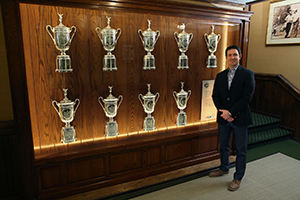
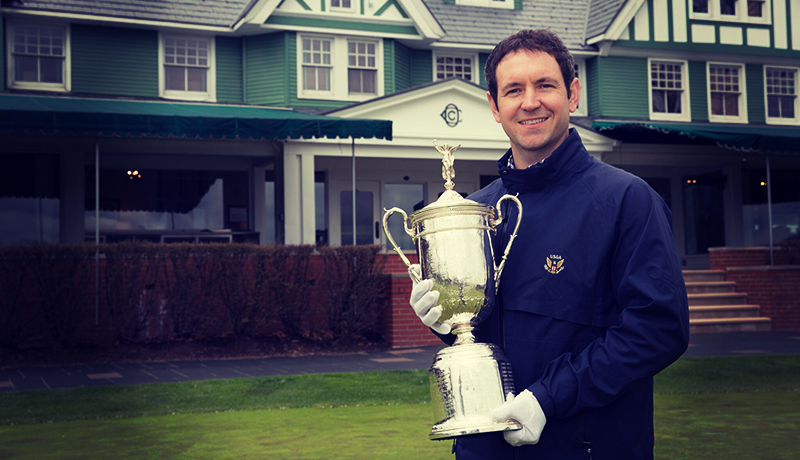
2016 U.S. Open Championship Manager Charlie Howe
Photo Courtesy of the USGA
Oakmont Country Club isn’t the official home of the U.S. Open — it just feels that way. As the host of the prestigious golf tournament a record eight previous times, it’s easy to see how the suburban Pittsburgh course has grown synonymous with the major. That bond will only grow stronger once defending U.S. Open champ Jordan Spieth, world No. 1 Jason Day and the rest of the field march onto the Oakmont greens again for this year’s installment on June 16 to 19.
“With our venue selection,” explains Dave Aznavorian, the United States Golf Association’s senior director of marketing, “we’re always looking to have a venue that’s iconic and can identify the world’s best golfer. We start there. We want to find the type of grand stage that can give us a venue that will be able to help identify the world’s best players.”
Charlie Howe, championship manager of the 2016 U.S. Open, echoes many of the same sentiments. In fact, during a recent conversation with Forbes Travel Guide, Howe spoke in depth about the USGA’s affinity for Oakmont, the U.S. Open’s fan enhancements and the best places around Pittsburgh to eat after a round.
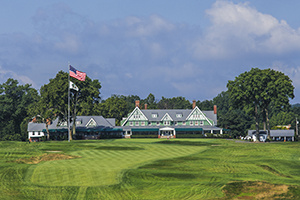
The Ninth Hole at Oakmont, Photo Courtesy USGA and John Mummert
What separates the U.S. Open from the other majors on the golf calendar?
In my personal opinion, and I think I share this with many people from the USGA, we see it as our country’s national championship. With Augusta National and the Masters, seeing as how, obviously, they host it every year, it provides its own allure and history. But that’s the unique part about the U.S. Open — we are at a different course every year. There are some that we go to more than others. For example, this year at Oakmont will be their ninth U.S. Open and that’s more than any other club in the country.
But you can break it down even further. Much like the British Open, [the U.S. Open] is open to everyone. When you look at it, it is the country’s national championship. Half of our field gets different exemption qualifications. For example, if you’ve won a U.S. Open in the past 10 years, you are exempt. If you’ve won the Masters, the PGA Championship or the British Open, you have a five-year exemption. As we get closer to June, we’ll look at the Official World Golf Rankings and some other qualifications. In essence, the other half of the field has to qualify through registering and submitting their applications. We’ve seen nine [thousand] to 10,000 people that are interested in competing locally and moving on to sectionals.
I’ll use 2008 as an example. That was really my first time seeing what a USGA championship looked like. Tiger Woods was clearly the No. 1 player of the era [but] he had to go to a full 18-hole playoff against Rocco Mediate, a 45 year old from Western Pennsylvania who had to go through qualifying. But he was playing better golf better than all but one person in the field. The U.S. Open identifies the best player — I wouldn’t say the best player in the world though a lot of times it does hold true to that — and who’s playing the best golf at that time period. That’s what’s so neat is that you do get the stories like Tiger and Rocco in 2008, which you won’t really see in any other championship.
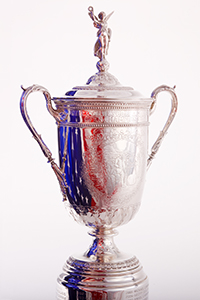
The U.S. Open Trophy, Photo Courtesy of USGA and John Mummert
What’s different about Oakmont from the last time it hosted the U.S. Open in 2007?
Physically, we’ve got a new upgraded spectator facility called the 1895 Club. If you look at the tier of our tickets, we sell gallery tickets; then you have the Trophy Club, which is an upgraded pavilion, like a sports bar setting, with air conditioning and plenty of TVs; then you have the 1895 Club, which we introduced in 2011, but it will be the first time we had it at Oakmont. From a footprint standpoint, we’ve introduced a new corporate hospitality facility last year at Chamber’s Bay, which was really a double-decker pavilion that we sold corporate suites. We actually have 15 suites at the top floor and 15 suites at the bottom floor. That will be located right at the 13th hole, a great Par 3.
But what I’m most excited about is really how we introduced mobile devices to our spectators. What I mean by that is them being allowed to bring them on site to the championship. Over the USGA’s long history, it was always a prohibited item. We allowed that in 2015. We certainly worked with our vendors to make sure the coverage was amplified and worked with the Verizons, Sprints, T-Mobiles and AT&Ts to enhance the coverage.
What that allowed us to do was have a mobile app. Now, when you come out to the championship, there’s some real use for it. You can track your favorite players, have access to the leaderboard, access the highlights. There’s going to be an upgraded search field. You can type in the letters “F-O” and “Rickie Fowler” will come up. All the food concession locations [will be on the app]. There will be a “train schedule,” if you will, where, if you’re sitting on the 15th hole, you can see [which players] are coming using our mobile app. You can plan your day and how you’ll move about the golf course. I think it will really enhance the spectator experience.
What are some tips for the best places to be on the course to see the action?
If this is your first visit to Oakmont, I think you’re in for a really good treat. It is one of the iconic golf courses in American golf. The history of the championship [is amazing]: 15 prior USGA championships, eight prior U.S. Open championships. Bobby Jones won a U.S. Amateur here. Jack Nicklaus won his first-ever tournament here in 1962, defeating Arnold Palmer in an 18-hole playoff. It’s a golf course that’s steeped in history.
But to say a specific location, I think you have to check out the iconic Church Pews. The Church Pews are really a bunker the length of a football field. It’s certainly a picture that you’ll see on a spectator information guide or a U.S. Open program. Whenever you see the Church Pew bunker, you don’t even have to think about what golf course that is. It is so iconic and unique to Oakmont. It really sits to the player’s left at the third hole when you’re on the tee and the player’s left on the fourth hole. It comes into play twice. It’s certainly a spectacle to see and, really, the majestic look to Oakmont.

Howe with the Hardware, Photo Courtesy of USGA
And then look at the last four holes at Oakmont and what that’s going to provide from an excitement standpoint on Friday as players are trying to make the cut. Also, on Sunday, when we’re looking to crown a new U.S. Open champion. You have 15, which is a great Par 4. We’ll have a considerable number of grandstand seats on these last four finishing holes. Look at 16, which is a pretty difficult Par 3, but somebody’s going to have to be aggressive if they’re trying to make up strokes on Sunday. Seventeen is a shorter Par 4 but players will, perhaps, try to go for the green, if they need a stroke. And then the 18th hole at Oakmont, I think, is just one of the best finishing holes in golf. We’ll have just about 16,500 grandstand seats for our spectators, which is really going to provide some fantastic viewpoints.
And then the vistas that you’ll be able to see on the golf course [are great]. On the golf course, you can stand at any point and truly see 17 other holes that you’re not standing on. It’s really unique from that standpoint and that’s a little different from 2007. There were trees along the Pennsylvania Turnpike. You might laugh if you’re not familiar with Oakmont, but the Pennsylvania Turnpike splits the golf course.
After a U.S. Open round, where would you suggest fans go for a bite to eat?
There are several places right down the street. If you’re staying at Oakmont or just kind of hanging out, walk down Hulton Road and go to places like Hoffstot’s or Chelsea Grille. There’s a great little breakfast and lunch place that I enjoy called What’s Cookin’ at Casey’s. This little community embraces the U.S. Open. At What’s Cookin’ at Casey’s, you see dinner plates signed by many of the golfers who’ve been through over the years. They got plates signed by Arnold Palmer, Jack Nicklaus and the director of golf here, Bob Ford, has a plate signed. Padraig Harrington and Angel Cabrera, too. They have it all surrounding a poster for the 2016 U.S. Open.
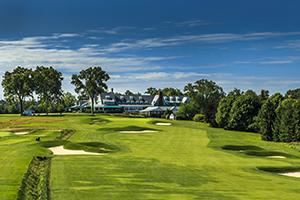
Oakmont’s Fabulous Fairways, Photo Courtesy of the USGA and John Mummert
There are some great bars in town, if you caught the morning action [live] but want to see the rest on TV. There are Carnivores and Oakmont Tavern. That’s just in the immediate area. You have Somma really almost across the street from the golf course. It’s a great pizza place. And stepping in there, it’s like Pittsburgh sports history. There’s not only U.S. Open memorabilia, but also Steelers, Pirates and Penguins [items as well]. It’s a neat little bar.
There’s not really a chain-restaurant scene [in the city]. I think Pittsburgh was ranked No. 1 by Zagat as “The Best Food Town in the Country.” You can see why. There’s a chef scene that seems to be pretty competitive. Downtown has certainly changed over the past several years to where you’ve got restaurants like Meat & Potatoes and Täkō. There are great places in Market Square like Revel and Roost. There is Sienna Mercato in the Cultural District downtown. The first floor is kind of a meatball joint where you build your own meatball, and upstairs is an open beer garden. Again, if you wanted to take a breather from the golf course but find a good place to enjoy the weather, upstairs at Sienna Mercato is a great spot.
It’s just been fun living here. I truly feel at home. I grew up in Richmond, Virginia. Pittsburgh is probably a little larger than Richmond but I see a lot of similarities in how great this community has been in welcoming me and my staff — but I think they’re like that even when I’m not here.
